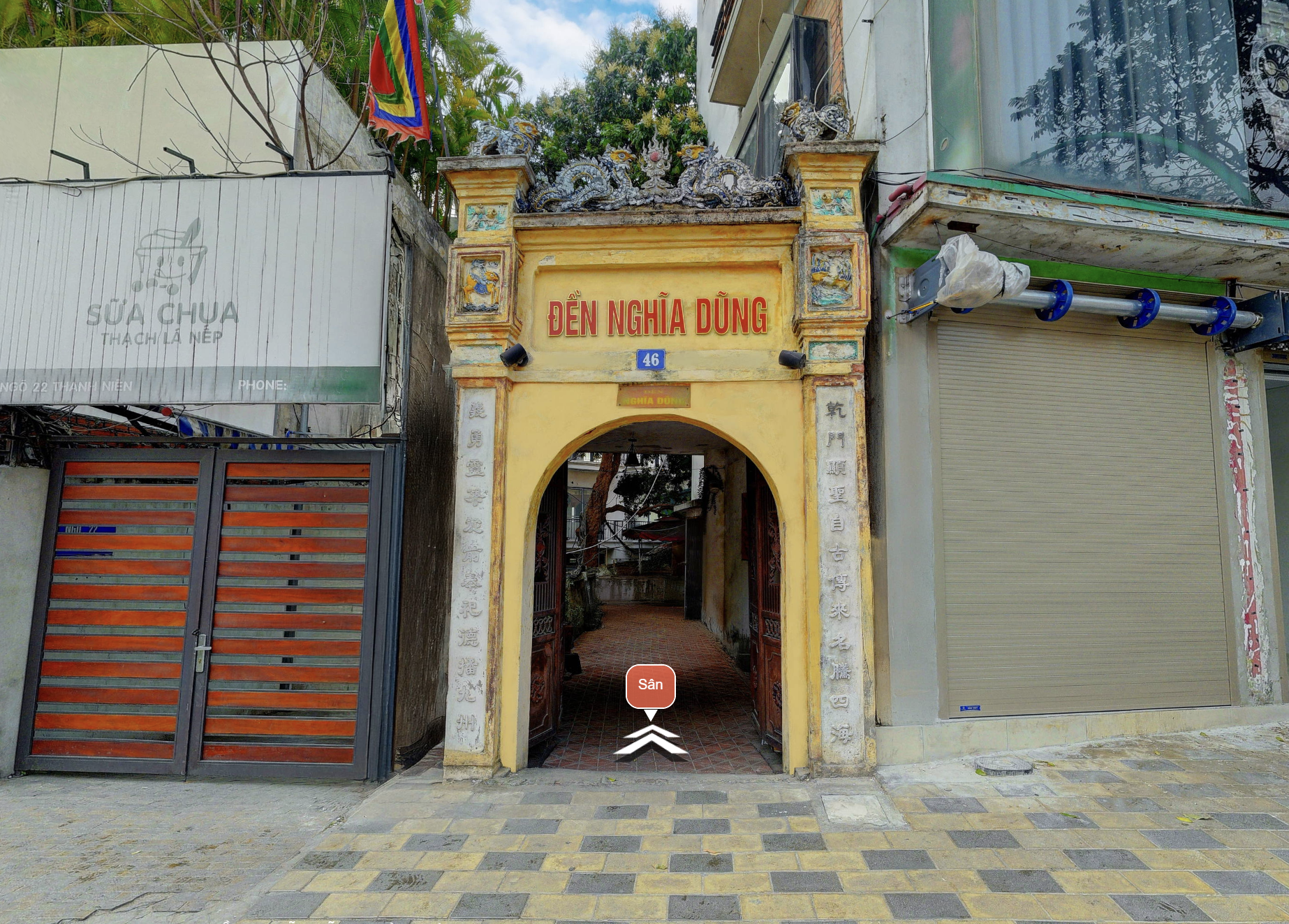

Introduce
The temple, formally named “Nghia Dung linh từ,” is located at No. 20, Thanh Nien Street, Yen Phu Ward, Tay Ho District, Hanoi City.
The temple was once located in Yen Hoa Ward, Thuong Commune, Vinh Thuan District, within the Thang Long Imperial Capital during the Lê dynasty. In the early reign of Thieu Tri (1841), Yen Hoa was renamed Yen Phu under Vinh Thuan District, Hanoi Province.
The stele currently preserved at the site indicates that the temple was constructed under Nguyen Van Khang’s patronage in the 10th year of Minh Menh’s reign (1829) to venerate the “Tứ vị Mẫu Cờn” (Four Holy Mothers). These deities were originally worshipped in Quynh Luu District, Nghệ An Province. The legend of the Four Holy Mothers has been recorded in historical chronicles and numerous folk tales in regions where “Mẫu Hải Cờn” is revered.
Although there are various versions of the legend, they all generally agree that these deities were originally the Empress of Emperor Song Duzong (China) and three daughters were honoured by the Vietnamese feudal court as National Mothers for their contributions to assisting King Tran Anh Tong and King Le Thanh Tong during their military campaigns against Champa. The legend of the Four Holy Mothers can be summarized as follows:
According to historical records such as “Việt điện u linh,” “Lĩnh Nam chính quái” and “Đại Nam thống nhất chí”, “Ô Châu cận lục”…, towards the end of the Trung Hung era (1292–1293), the Song Dynasty's army was defeated by the Mongol forces at Nhai Son. Emperor Song Bing was forced to flee to the sea with his royal family, over 800 courtiers, and retainers aboard ships in imminent defeat. However, with no escape and being relentlessly pursued by the enemy, the emperor and his entourage ultimately threw themselves into the sea to end their lives. The corpse of the Empress Dowager of the Yang family (some records state she belonged to the Zhao family) and the three princesses drifted to Con Estuary in Phuong Can Village, Quynh Phuong Commune, Quynh Luu District. Their complexions remained rosy as if they were still alive. The local fishermen, moved by compassion and considering the event supernatural, buried them properly and built a thatched shrine for worship. When embarking on voyages, fishermen and seafarers would come to the shrine to offer prayers, and their wishes were often granted.
The “Đại Việt Sử Ký Toàn Thư” describes the celestial appearances of the “Tứ vị thánh Cờn” as follows:
“In the 19th year of Hưng Long (1311), during the winter, in December, the King personally led an expedition against Champa because its ruler, Che Chi, had acted treacherously. In the 20th year of Hung Long (1312), during the summer in May, Che Chi was captured and brought back. In June, upon returning from Champa to the capital, the King ordered the construction of a temple dedicated to the deity at the Can Hai seagate. Previously, when the King set out on his campaign against Champa, he had stationed his troops at the temple near the Can Hai seagate (formerly called Can but renamed to avoid using a tabooed royal name). That night, he dreamt of a divine lady who tearfully addressed him: I was a consort in the Zhao-Song royal family. When the enemy invaded, I was overcome with despair, trapped in the rough waters, and floated to this location. The Jade Emperor has long recognized me as the goddess of the sea. Now that Your Majesty has embarked on this campaign, I respectfully offer my assistance in achieving victory. Upon waking, the King summoned the village elders to verify the story, performed a ritual offering, and continued his journey. As a result, the sea remained calm. The royal army advanced directly to the capital of Do Ban, capturing the Champa ruler and bringing him back. When the King awoke, he gathered the village elders to confirm the story, made a ritual offering, and went on his journey. As a result, the sea remained calm. The royal army proceeded immediately to the capital of Do Ban, seizing the Champa ruler and bringing him back. From then on, the King commanded the authorities to establish a temple in her honour, with offerings made in all four seasons.”
In the first year of Hong Duc (1470), during the reign of King Le Thanh Tong, the Champa launched an invasion. The King personally led his army to battle against the enemy.
Upon arriving at Can Hai, the King visited the sacred temple to perform rituals and pray for divine support in aiding his troops. As expected, victory was achieved. On his return, King Le Thanh Tong visited Con Temple to express his gratitude for the blessings of “Thánh Nữ.” He conferred the title “Đại Càn Thánh Nương Quốc gia, Nam Hải Tứ vị Thượng đẳng thần” and issued a royal decree allowing coastal regions to build the temple in her honour.
Additionally, the King composed the poem “Càn Hải Môn Lữ Hành” (Resting at Càn Hải Seagate), in which two lines read:
Phong đào cửa tỉnh Anh Tông mộng.
Hương hỏa do khâm Thánh Nữ từ.
Interpretation:
Hương hỏa còn truyền đến Thánh mẫu.
Sóng xô thức tỉnh giấc Anh Tông.
Nghia Dung Temple is dedicated to the veneration of the Four Holy Mothers, which includes one Empress Dowager of the Yang family, one Empress of the Guo family, and two Princesses of the Zhao family.
Artifacts
Map
Nearby Places
No. 43C, alley 497, quarter 2, group 15, Lac Long Quan Street, Nhat Tan Ward
3.42Km
No.6, Lane 319, An Duong Vuong Street, Phu Thuong ward
5.74Km
Lane 242, Lac Long Quan Street, Buoi Ward, Tay Ho District, Hanoi.
No. 20, Lane 472, Cluster 3, Lac Long Quan Road, Nhat Tan Ward, Tay Ho District, Hanoi.
No. 35, Lane 416, Lac Long Quan Road, Nhat Tan Ward, Tay Ho District, Hanoi.
5.02Km
No. 07, Lane 30, Tay Ho Road, Quang An Ward, Tay Ho District, Hanoi.
2.43Km
Residential Area No. 5 (No. 3, Lane 200, Au Co Road), Tu Lien Ward, Tay Ho District, Hanoi.
2Km
Residential Area No. 5 (No. 3, Lane 200, Au Co Road), Tu Lien Ward, Tay Ho District.
2.56Km